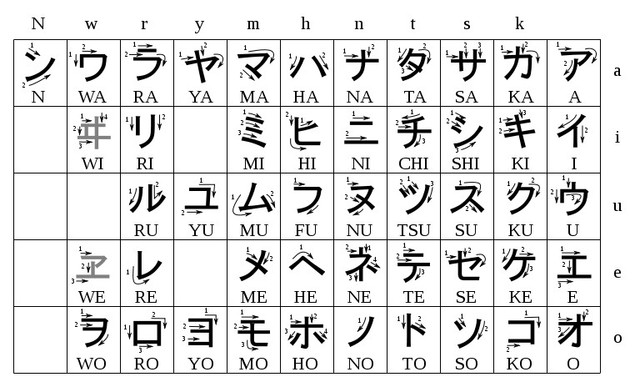When I talk to people about learning Japanese..
there seems to be a very western response to learning languages like japanese.. the immediate "Oh that's so difficult!" or "Isn't that completely the opposite to English?" However this is a misconception and Japanese is actually one of the easier Asian language systems to learn!
The Japanese alphabet is divided into four main writing systems:1.) Hiragana ひらがな
2.)Katakana カタカナ
3.)Kanji 漢字
4.)Romanji (English)
Whilst this may seem intimidating you'll find that there are a lot of overlaps and the simplity of japanese grammer and pronunciation in comparision to English more than compensates.
- ひらがな Hiragana
- Hiragana is the fundamentally the key alphabet in Japanese and the alphabet you'll most urgently need to learn. While all the other alphabets can be substituted with hiragana, it remains as the building block to Japanese writing. Hirgana can be used to create any sentence but this doesn't happen (See Kanji for why). The most common use of hiragana is for pronunciation and the expression of grammar such as articles 'A', 'The' and preposition 'To' and 'from' ect..As hiragana is a derivative of kanji you can see aspects of it repeated in the use of kanji.
- カタカナ Katakana
- Katakana has become more commonly used in the Japanese language over the last hundred years. As the use of katakana is reserved mostly for incorporating foreign words into Japanese, it wasn't used until western culture became more influential in Japan. While you often won't need it for basic learning, you'll find names, places and universally common nouns are now spelled out in katakana. Katakana is also a derivative of kanji and as you become more familiar with kanji you'll notice katakana is nearly identical to kanji radicals (Radicals -see kanji)
- 漢字 Kanji
- Kanji is considered to be the root of all other Japanese alphabets, it's literal translation is Chinese characters. I you're familiar with Cantonese or to a lesser extent mandarin you'll know that pictorially the characters are identical. However the meaning of Japanese and Chinese characters even if identical can be different. Kanji is the culmination of several smaller radicals or strokes that form one unit. Each line or stroke is a pictorial reference to a word and these radicals put together combined to make more complex meanings. By learning hiragana or katakana you will essentially be learning aspects of kanji but in order to be able to truly write in Japanese kanji is essential. Kanji is used to signify nouns, pronouns and verbs..basically everything but the exception of grammar particles (or articles if you prefer). If you are truly dedicated to Japanese, you'll be unable to level up without knowledge of basic kanji principles.
- Romanji
- I've included romanji in lists because it's not always explained in Japanese language studies even though at beginner level it is the most consistently used. This again can be literally translated as 'roman characters' in other words how we write Japanese in using English letters. This guide will be using romanji in order to introduce the Japanese basics!
 |
| this charts shows the hiragana characters and a kanji example beside |
Katakana:


No comments:
Post a Comment